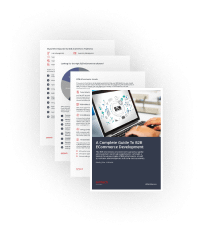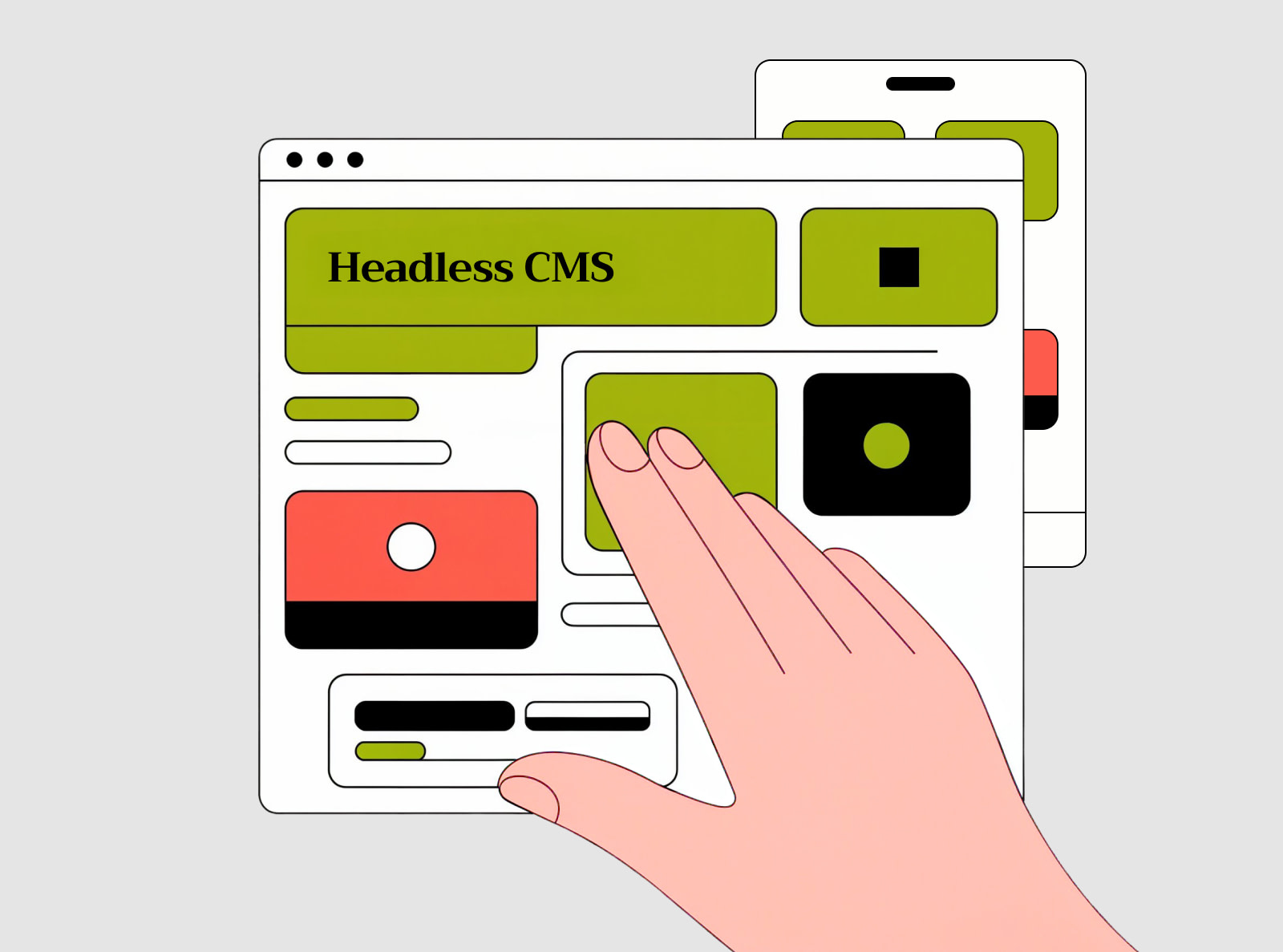Digital products need to be launched faster and scaled easier. eCommerce business owners seek a more innovative way to build their projects.
However, most teams continue to waste their time building traditional, backend-heavy systems. This slows everything down and racks up costs. Every time you launch a storefront, promo page, or portal quickly, that might be a stumbling block.
This is where headless CMS can be a gamechanger. The key benefits of headless CMS become especially clear when speed, flexibility, and long-term scalability are top priorities. The approach decouples content management from presentation. It offers a radically more efficient way to develop and grow eCommerce products.
Let’s unpack how this works and why so many businesses start switching to a headless approach.
What Is a Headless CMS?
The idea of the headless approach relies on a content management system that manages only the backend, basically, your content and data. Ultimately, it leaves the frontend (what users see) up to you.
In simpler words, instead of delivering pages, it delivers raw content via API. With a headless approach, it is possible to form database structures without involving backend developers.This separation unlocks the powerful benefits of a headless CMS.
Why Businesses Choose Headless CMS
Both new and established online entrepreneurs are put under pressure when trying to deliver their products to the target audience fast. Every day, dozens of landing pages, online stores, and client portals go live.
Traditional development no longer suffices. It is often weighed down by complex architecture, duplicated logic, and redundant backend work. Implementing headless approach is a more advanced option. One of the key headless CMS advantages is that it removes those obstacles by offering:
- Prebuilt APIs with no manual coding needed.
- An Instant admin interface where content editors can work right from the start.
- Parallel development with both frontend and content workflows run independently.
- Minimal backend setup that does not require a separate DevOps or backend team.
This enables frontend teams to launch MVPs and iterate quickly, without being hindered by backend bottlenecks. Meanwhile, it is important to consider pros and cons of headless CMS.
Top Benefits of Headless CMS
Now it is time to dig into the main reasons why use a headless CMS when launching and scaling your eCommerce projects despite size and niche.
Faster Time to Market
First of all, with a headless CMS, there is no need to build APIs from scratch or wait for backend components to be ready. Your marketing team can start with frontend development immediately. This shortens launch timelines by up to 50%.
Lower Development and Maintenance Costs
No backend team? No problem. You do not need one. The CMS handles API generation and admin tools out of the box. Maintenance is also more cost-effective in the long term, with fewer moving parts and no legacy backend code to manage.
Developer Freedom & Modern Tech Stack
You can use the tools your developers already love. They get complete control over how content is rendered and can create fast, lightweight experiences without the constraints of a monolithic CMS.
Headless Content Delivery
Delivering content across multiple platforms is simpler with the headless approach. Your content lives in one place and gets delivered anywhere either mobile, desktop, IoT, or even wearables. It’s a future-ready architecture that doesn’t lock you into one presentation layer.
Better Collaboration Between Teams
Frontend developers, designers, and content editors can all work together simultaneously. Editors get an intuitive admin panel to manage content. Developers get clean APIs. No one is waiting for anyone.
Future-Proof Architecture
With headless CMS solutions you may easily switch frontend frameworks or add a new channel. It is easy to redesign your store. No need to touch the backend or migrate content. A headless setup gives you the freedom to evolve without requiring a rebuild.
Let’s look at how headless CMS development is applied in real-world projects to achieve speed, flexibility, and scalability.
Headless CMS in Action: Real Use Cases
Here’s how different types of teams are using headless CMS to build more innovative and faster-to-go eCommerce projects, especially when integrated with tools like contract management software to streamline business operations and ensure compliance:
eCommerce startups launching MVPs in weeks instead of months
For startups, time-to-market can make or break success. Traditional backend development often takes months and requires a full-stack team. With a decoupled CMS, these startups skip backend setup altogether.
They start with a frontend framework in a headless CMS for content and product data, and start testing with real users within weeks.
Brands are modernizing legacy websites by migrating only the frontend
Legacy websites built on outdated CMS platforms often struggle with slow performance, poor mobile responsiveness, poor digital presence, and limited flexibility.
Rather than rewriting the entire system, many brands choose to keep their existing CMS in the background and “go headless” by rebuilding only the frontend.
This approach enables them to modernize the user experience while still utilizing the tools their teams are already familiar with.
Marketplaces adding mobile apps without changing backend logic
Headless CMS makes omnichannel delivery seamless. Marketplaces, particularly those operating across multiple regions or verticals, often require launching native mobile apps to reach new customers.
With a headless architecture, they don’t need to rebuild or duplicate backend systems. The CMS serves the same content to websites, mobile apps, and even third-party platforms via rest APIs.
Developers simply build a new frontend (e.g., in React Native or Flutter), connect it to the existing CMS, and deploy.
Enterprise teams supporting dozens of microsites with a single CMS
Bigger projects often manage dozens of microsites. Managing them all from a traditional CMS is complex. With a headless approach, enterprise teams use a single CMS instance to power content across all digital assets and channels. APIs make it easy to share or tailor content as needed.
Moreover, content editors can work independently, while developers maintain a unified codebase.
Security and Performance Benefits
A headless CMS isn’t just about faster development — it also gives your eCommerce project a serious edge in terms of security and performance. By design, the architecture promotes cleaner separation between systems, tighter control over deployment, and faster frontend performance. Here’s how:
Teams are not tied to a specific infrastructure. With a headless CMS, you can host your frontend anywhere. It might involve static site generators on platforms like Vercel or Netlify, to globally distributed edge networks.
How Headless CMS Speeds Up Development and Cuts Costs
Headless CMS drastically reduces development time and eliminates many of the high-cost, high-effort tasks associated with traditional backend-heavy builds.
In a traditional setup, you often have to design, develop, and test a custom admin interface so content editors can manage pages, products, or media.
That may take weeks or months of work. With a headless CMS, the admin UI is already built and ready to go out of the box. This ready-to-use structure is one of the major advantages of headless CMS for content teams and developers alike.
Content teams can start adding and editing content immediately, with no extra development time. This kind of efficiency is one of the biggest headless CMS benefits for growing eCommerce projects. Additionally, most headless CMS platforms provide clean, intuitive interfaces that require minimal to no training.
Building secure, scalable APIs from scratch also takes time and extra expertise. You need to define data models, handle validation, implement security, write documentation, and maintain it all as things change.
Headless CMS platforms eliminate this entire process by automatically generating APIs for all your content types. As soon as you create a new content model (a product page, blog post, or testimonial), the system instantly exposes it through REST or GraphQL.
In a traditional stack, backend development encompasses setting up databases, authentication, role management, server configuration, and CI/CD pipelines. All of this takes time, budget, and specialized skills.
With a Headless approach, it is possible to remove most of that complexity. They are often fully managed, cloud-based solutions with built-in security, scalability, and backups.
In monolithic systems, frontend developers typically have to wait for backend APIs or data structures to be finalized before they can start work. This causes bottlenecks and slows the entire project.
With a headless approach, your teams can work in parallel. As soon as the content structure is defined in the CMS, frontend developers can start building components and templates using real or mocked API data.
Is Headless CMS Right for Your Business?
A headless CMS isn’t the default choice for every project. However, for the proper use case, it can unlock speed, flexibility, and long-term scalability. The key is knowing whether your current and future needs align with what headless architecture is built for.
Choose headless if:
You Need to Move Fast
If you’re building an MVP, launching a new online store with a digital signage, or testing a product in-market, a headless CMS enables your frontend team to get started immediately without waiting for backend infrastructure. You can define your content models, pull data via APIs, and get your product in front of users much faster than traditional stacks allow.
You Need Freedom to Grow across Platforms
Headless is a good option when content needs to be reused across multiple channels: websites, mobile apps, digital kiosks, and even smart devices. Instead of duplicating content or managing separate systems, you publish once and distribute anywhere.
You Need Improved Performance
You can host your frontend on a CDN or edge network, reducing time it takes to paint and serve users globally with ease. Plus, you are free to evolve your tech stack as better tools emerge without having to switch between platforms.
Choosing a Headless CMS: Key Factors
Not all headless CMS platforms are built the same. Some focus on developer control, while others prioritize editor experience. To find the right one for your project, consider the following:
API Flexibility and Documentation
Look for REST or GraphQL support, well-documented endpoints, and custom content modeling. Your frontend depends on these APIs to fetch content. The more flexible and reliable they are, the smoother your development process will be.
Editor Experience (admin UI)
You want to have a clean interface, role-based permissions, inline previews, and easy content structuring. Your content team will use this daily. If it’s too technical or confusing, they will need assistance from developers.
Hosting Options and DevOps Readiness
Decide on self-hosted vs. cloud, CDN integration, static site generation support, and DevOps compatibility. Some CMSs are SaaS while others are open-source and self-hosted. Choose based on your team’s DevOps comfort level and the level of scalability you require. Cloud-based solutions are faster to start; self-hosted solutions give you more control.
Ecosystem and Active Community
You may need community plugins, support forums, tutorials, frequent updates, and third-party integrations to enhance your experience. A strong ecosystem enables faster problem-solving, more seamless integrations, and ongoing platform enhancements. Make sure you have enough info on how to add them.
Conclusion: Headless CMS — Freedom to Grow
A headless CMS gives eCommerce teams what they require most: speed, flexibility, and control.
It removes the limitations of old systems and lets you focus on delivering real value to users, whether it’s a sleek storefront, a high-converting landing page, or a scalable product ecosystem.
Want to build better, faster, and for the future?

